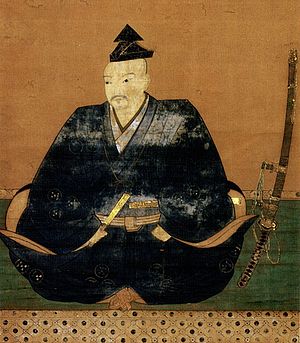m (Remove some templates and interwiki links, delink non military terms and cleanup, replaced: == → ==, == → ==) |
m (→Further reading: Remove some templates and interwiki links, delink non military terms and cleanup) |
||
| Line 62: | Line 62: | ||
{{People of the Sengoku period|state=autocollapse}} |
{{People of the Sengoku period|state=autocollapse}} |
||
| + | |||
| ⚫ | |||
{{DEFAULTSORT:Mori, Takamoto}} |
{{DEFAULTSORT:Mori, Takamoto}} |
||
| Line 69: | Line 71: | ||
[[Category:Daimyo]] |
[[Category:Daimyo]] |
||
[[Category:Deaths by poisoning]] |
[[Category:Deaths by poisoning]] |
||
| ⚫ | |||
Revision as of 14:21, 3 December 2017
| Mōri Takamoto | |
|---|---|
 | |
| Native name | 毛利隆元 |
| Nickname | Shōnotarō (少輔太郎) |
| Born | 1523 |
| Died |
September 18, 1563 (aged 40 or 41) |
| Place of birth | Sarukake castle, Aki Province |
| Place of death | Yoshida, Aki Province |
| Allegiance |
|
| Rank | Daimyō (Lord) |
| Unit |
|
| Battles/wars | Battle of Miyajima (1555) |
| Relations |
Father: Mōri Motonari Mother: Lady Myōkyū |
Mōri Takamoto (毛利 隆元, 1523 – September 18, 1563) was a daimyō (feudal lord) of Aki Province during Japan's Sengoku period. He was the eldest legitimate son of Mōri Motonari.
Life
Born in Tajihi, Aki Province, Takamoto was sent at the age of 14 to Suō Province as a hostage of Ōuchi Yoshitaka. This was done to ensure his father's loyalties to Ōuchi. He was allowed to return home in 1540, three years later, to the Mōri castle of Yoshida Kōriyama.
In 1555, Sue Harukata, one of Ōuchi's vassals, staged a coup and forced Ōuchi Yoshitaka to commit suicide. He was then attacked by Mōri Takamoto and his father, and was defeated in the battle of Miyajima.[1] The Mōri, defeating the Sue/Ōuchi forces, thus rose to power in the Chūgoku region (the western area of Honshū), and would remain a powerful and influential faction for much of the rest of the 16th century. Upon his father's retirement two years later, Takamoto inherited formal leadership of the family, but his father Motonari continued to wield actual control over the clan's affairs.
When Ōuchi Yoshinaga died that same year (1557), the Mōri saw an opportunity to seize the Ōuchi clan lands; they had to consider, however, the Ōtomo clan to the west and the Amago clan to the north who entertained similar ideas. Takamoto gained a considerable boost to his power, however, in 1560–1563, when he was appointed by Shogun Ashikaga Yoshiteru as Governor (shugo) of Aki, Nagato, Suō and Bitchū Provinces. Amago Haruhisa died suddenly in 1560, and Ōtomo Sōrin began to devote significant resources to attacking the Amago territory.
At the advice or orders of his father, Takamoto seized the opportunity to attack the Ōuchi territory. He was leading the Mōri armies through Bingo Province when, on September 18, 1563, he suddenly died of poisoned food at the age of 41 (or, the first day, ninth month, of the year Eiroku-6, by the Japanese calendar). Historians have since identified Wachi Saneharu, a local Bingo samurai, of committing the deed.
Mōri Motonari accused a number of samurai of conspiring in the assassination, and forced them to commit seppuku. Takamoto's son Mōri Terumoto was selected as his heir, but Motonari continued to wield the true power.
Family
- Father: Mōri Motonari (1497–1571)
- Mother: Myōkyū (1499–1546)
- Siblings:
- An unnamed sister
- Lady Goryū, wife of Shishido Takaie (d. 1574)
- Kikkawa Motoharu (1530–1586)
- Kobayakawa Takakage (1533–1597)
- Half Siblings:
- Ninomiya Naritoki (1546–1607)
- Mōri Motokiyo (1551–1597)
- Mōri Motoaki (1552–1585)
- Izuha Mototomo (1555–1571)
- Amano Motomasa (1559–1609)
- Suetsugu Motoyasu (1560–1601)
- Kobayakawa Hidekane (1567–1601)
- Wife: Lady Ozaki, daughter of Naitō Okimori and adopted daughter of Ōuchi Yoshitaka (1527–1572)
- Children:
- Mōri Terumoto (1553–1625)
- Lady Tsuwano, first wife of Yoshimi Hiroyori
References
- ↑ Turnbull, Stephen (1998). The Samurai Sourcebook. Cassell & Co.. ISBN 1854095234.
- This article is derived from the corresponding one on the Japanese Wikipedia.
Further reading
Template:People of the Sengoku period
The original article can be found at Mōri Takamoto and the edit history here.